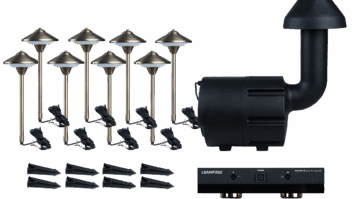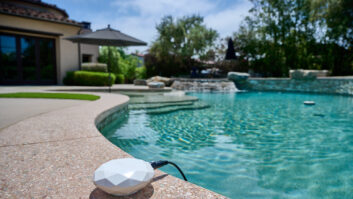As one year ends and another begins there is a tendency in some quarters to take a look back and review the year just ending. Notice is made of what changed and what didnt, what was a hit and what missed the mark, what came to market, and what is still vapor-ware.
As best as possible, well resist the temptation to either look back or attempt to guess what is ahead. Because what is past is past, and what is ahead is unknown, perhaps a better approach would be to simply point to the areas of interest in the worlds of audio and video, distribution and display, data and control, storage and content management for the year ahead. This roadmap will act as a pointer to things to look at during CES or a post-CES discussion session, as well as providing some suggestions as to where you need to keep your antennae up on technologies and decisions about them that could, either individually or in combination, have a dramatic impact on your business.
Digital TV
What will be the date certain for the end of analog transmission by terrestrial television broadcasters in the U.S.? That matter was examined here in considerable detail recently, and it seems as though a date might even be agreed to by the time you read this. Remember to look beyond the analog shut-off date, itself. Keep an eye out for the final word on any Congressional grant to the public for video vouchers. How will the combination of the end of the digital transition and the way in which it is paid for affect your clients?
PlayStation3
When will Sony Computer Entertainment (SCEA) introduce PlayStation3, and at what price? Microsoft has already launched the Xbox 360 to sellout proportions. The impact on home theaters has yet to be gauged, but with expanded online services, high-definition video, and surround sound and immersive games in all genres, its a cant lose proposition. Sony will up the ante with PS3, thanks to Blu-ray disc playback on board, extensive connectivity options, and high-definition video up to a 32:9 presentation when both of the HDMI outputs are used. At this point the intro date could be anything from late spring to mid-year or beyond, but we probably wont know until the E3 show in mid-May. It is expected that the first standalone Blu-ray players will carry high prices. Will a lower price for the PS3 console, made possible by the razors and blades business model of the video game console market, undercut your sales of Blu-ray players? Will PS3 simply help push the demographic for game consoles to a slightly older skew that more closely matches the profile of your customers, thus adding more to your sales? Time will tell.
Blu-ray and HD DVD
Everyone knows that all sorts of questions remain to be answered about these high-definition video disc formats. Are we really past the point of no return for any hope of a last-minute surprise that will bring us a single, consolidated format in place of two competing formats? Presuming that there will be two formats, which will be first to market? What will the available title list look like at launch? What will the pricing be for the players? What will the pricing be for the discs? Will the studios insist on plugging the analog hole such that early video displays without DVI or HDMI connectivity will not be able to show the high-def images ? When will the first titles using the higher capacity 50-Gb Blu-ray discs appear? Exactly how will multi-channel, high-resolution audio connectivity be handled in the first round of players? There are many things to be on the lookout for here that will have a significant impact on your business.
Dolby Digital + and DTS-HD
Again, the mere mention of the format names raises questions and important issues that will need accommodation both in terms of equipment installed for the present and the way you plan installations and client upgrades to be as future-proof as possible. Initial players will probably have these formats output through analog jacks, much as todays DVD-Audio and SACD players do. In addition, there also will be some output via PCM through HDMI, but the exact details still appear to be pending. What will you need to plan for in terms of both hardware and software? Which, if any, of the newer surround processors and AV receivers introduced during 2006 will have the DSP chops that will allow upgrade to native processing of these new formats? Will the current HDMI 1.2 connectivity standard, or something beyond that be required? Look for the answers to these items; your customers most certainly will.
HDMI: Where Will It Go?
The current HDMI 1.2 products accommodate everything up to SACD, but most observers believe that a new format at 1.3 or higher will be required as the need for higher resolution 1080p video and advanced codec audio (as noted above) stretch the limit of the current HDMI silicon and software solutions. There will be much talk about this in the on-line forums that may create some anxiety on the part of your clients at the same time as accurate information may be sparse. Youll just have to follow this one as it moves along and be prepared to act quickly when the new gear is available.
Display Port
While we concern ourselves with the progression of HDMI connections in the consumer world, the computer industry is working on a different digital video display connection standard called Display Port. With the penetration of HDMI growing exponentially on a daily basis, it is unlikely that Display Port will have any significant impact on the consumer video world, but you never know. Look over your shoulder occasionally for news on this one.
1080p
The electronic capability to deliver 1080i has always been a part of the HDTV standards menu, but until recently displays that were capable of not only displaying the 1080i signals, but internally de-interlacing them for display as fully 1080p were few and far between. Toward the end of 2005 that changed, with front and rear projectors as well as LCD direct view displays increasingly sporting the 1080p moniker. What will be the place of 1080p in the year ahead, and how will that influence product and market dynamics? PDP displays will certainly begin to offer 1080p, but at what size and what price? LCD direct view products will most likely offer more 1080p-equipped models, but will it continue to be a differentiator to validate high prices for first-tier brands against the onslaught of second- and third-tier brands? When, and at what price, will we see 1080p rear-screen projectors with a full 1920×1080 pixel matrix arrangement as opposed to the current use of wobulation and similar technology to create the 1080p images? Will the increased availability of 1080p force the hand of those responsible for HDMI and connectivity technologies to make it possible for 1080p sources to be connected to displays? There are a wide range of questions surrounding 1080p, with as many involving its ability to help support specialist pricing as about the technology side of 1080p program delivery or display. This is a hot button to watch, with particular attention paid to what may be coming up fast in your rear view mirror from the big-box stores and online retailers.
LCD Improvements, Price Reductions and Sources
As the years roll over from one to another, LCD direct-view displays are still priced higher than comparably sized plasmas, but will that still be an operative statement 12 months from now? It is not an exaggeration to say that literally tens of billions of dollars are being spent in Japan, Korea, and Taiwan to build the new Gen.6, Gen.7, Gen.8, and perhaps soon even Gen.9 fabrication plants, or fabs that manufacture the LCD modules that will help feed what has become an insatiable demand for LCD displays around the world. With the limitations of PDP manufacturing making it impractical to build plasma sets under 37-inches wide, LCD is the de facto winner in the under-32-inch size category, but these new fabs are designed for high-volume production of 37-inch panels and up. Will LCD be able to reach parity with PDP, or sensing that, will PDP prices at the 42- and 50-inch size simply continue to drop? Will LCD be able to compete effectively in the 50-inch and above size bracket where it is still priced considerably higher than PDP? Will the output of the new fabs change that by making 65-inch size range LCDs competitive where 61- and 63-inch plasmas have been a rarity? How will the first-tier brands react to the growth of former third, and even second-tier brands such as Westinghouse and Syntax that are showing the muscle needed to attempt to claim first-tier status with technology, but have mixed specialist/mass market distribution? Its gonna be interesting.
PDP
Questions in the year ahead for plasma displays are more than simply to see if PDP can continue to find sales in the face of increased competition from LCD. The holiday season is still in swing as this is written, so it is too soon to see if the magic $999 barrier for a 42-inch ED-PDP will be broken with regularity. It seems as though some retail pricing for PDP has been in a free-fall, but it has to stabilize somewhere for both mainstay sizes, 42 and 50 inches. But what will that mark be, and yet once more, what products will the specialist have in their quiver to shoot back at the mass merchants, direct retailers and warehouse stores? As noted above, will 1080p panels come to the specialists rescue, or will it be in the form of even larger size panels, such as the long-promised 71-inch-wide unit from LG? With pressure from LCD on both sides of their size range sweet spots, what will your plasma display inventory look like a year from today, and how will you best manage it between now and then?
New Display Technologies
At least two pretenders to the display throne may see 2006 as the year they begin to break through after years of development. On the projection front, LCoS may once again make a try at marketplace acceptance, something it is garnered under the brand-specific versions sold as D-ILA from JVC and SXRD from Sony. However, where Intel and Philips, among others, were unable to create high-volume sales for LCoS, will Brillian finally be able to do the trick thanks to their acquisition by LCD up-and-comer Syntax Olievia? If there ever was going to be a year to look for LCoS to have a make or break, this could be it.
As a newcomer to the display scene, SED has no past history, though it has been in development for a number of years. As you read this at CES, more details about the pricing and introduction of SED-based products should be available, but that is just the start. Will the product be captive to its co-developers, Toshiba and Canon, or will they make it available to other brands? How competitive will SED be in terms of pricing as we all do the natural thing and compare it to both LED and PDP technologies and products? Will SED be a shelter product for specialists and custom installers, or will it show up in the big box stores without our market having much of a window of exclusivity? In parallel with SED, what, if anything, will be the place of the underlying FED technology in the big screen world? Will anyone else try to compete with similar products?
Looking at the potential for new display technologies there is always the possibility that something currently known about only in some skunk-works lab may end up becoming the disruptive technology no one considered? Will OLED or technologies such as iFire revolutionize the direct view market? Only time will tell.
Pod Stuff
In many ways, 2004 was the year of the pod, with all sorts of products designed to extend the usability of Apples incredibly popular portable music player. Of course, as the year begins, iPod is also a video player as well. Where will Apple take us in the year ahead? Will the video capability become something more than just playback of network programs for those on-the-go? Where Windows-based computers have had an ever-increasing video capability with Windows XP Media Center Edition, the Mac side of things has not seemed to pay that much attention to integration with off-air or cable tuners and recording. At least not so far.
Remember that an iPod alone is a dumb device with a hard drive. Thus, think of an iPod as being a client device that only works in conjunction with a computer programmed with iTunes. Is iPod/iTunes going to give DVRs a run for their money? Will there be HD capability if the storage can handle it? Who knows? Will Apple continue to support the current bottom connector in the inevitable future video-equipped iPods, or will something else take its place? This type of thing will have you thinking quickly and on your feet, as many had to do when the current range of iPod products dropped the top connector, rendering remote controls using it useless with the new models. Best advice here? Keep selling, keep remembering the tie to the computer where the content is really stored, and be ready to adapt.
Where Do Phones Fit In?
Remember when a phone was a phone? Todays phones have not only cut the cord, but they are increasingly complete communications and entertainment devices with on-board mega-pixel cameras, full PDA and e-mail functionality and music players. That trend is sure to continue in 2005, with last years question of How do I connect a clients iPod to a system? to How do I connect their phone to a system? Its easier said than done, but you are going to have to face this in the year ahead.
Look for at least two types of mini-format versions of the current solid-state memory cards to be part of the mix, along with increasing use of mini-USB cables as a gateway into clients phones. Add a multitude of hard-wire connectors and increasing availability of Bluetooth and you have something that the average cell phone store cant handle. You can, and while you might not offer cell phones any more than you would sell video game consoles or iPods, integrating the new cell phones into clients systems is clearly a great value added opportunity for the custom installer.
IPTV
Count the ways video comes into your clients systems now, and add at least one more for the year ahead. In addition to over-the-air analog, over-the-air digital, cable, digital cable, satellite, DVD, VCR, and the odd LD player still hanging around, IPTV is being positioned to be a big trend for 2006. Using IP delivery for video programming in a live streaming format as well as in download and store forms such as the way Apple delivers iPod videos and MovieLink and others deliver full-length movies is a technology on an upward trend. Movies and more on your computer, news clips, sports and short form programming and more on your cell phone, movies, videos and more on portable players are all possibilities. You can be in the middle of this if you watch where this trend takes us.
Wireless Technologies.
With 802.11b/a/g firmly established, the next frontiers for wireless networking are 802.11n and WiMax. By this time next year you will know those acronyms well, both for the technologies that they represent and the products and services that you will become involved with to use them in home network systems. Anyone content to stay with the current wireless topologies will be in for a rude surprise a year from now if they dont keep up to date on where these two acronyms lead us all in 2006.
No New Wires Networking.
For all the success of wireless, and for the security and familiarity of traditional wired networks, dont count out what could be called no new wires networks, the methods that use a homes existing infrastructure to deliver broadband data without the need to install new wires. The growth of connected devices such as VoIP phones, online connected video games, IP cameras and more will inevitably find even the most network-adept installer up against the wall…literally.
While HomePNA has faded out, expect this to be the year when data over AC wiring (HomePlug) and/or coax (MOCA) make new runs at the no-new-wires marketplace. No new wires may mean a good deal of new business for you if you understand where to apply it.
This is only the beginning of a list, but weve room for only so much this month. Just as the point here is to give you a shopping list and a technology to-do roster for the year ahead, the questions raised above will frame many of our reports in this space as the new year progresses. Well do our best to provide the news and the framework for your own analysis, as part of your own data gathering process. Keep on the lookout, and have a happy, healthy, prosperous and above all, peaceful New Year.
Michael Heiss ([email protected]) is a technology and marketing consultant based in Los Angeles.







